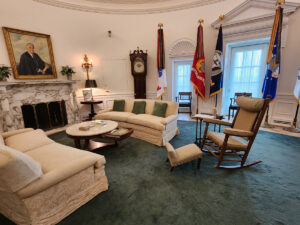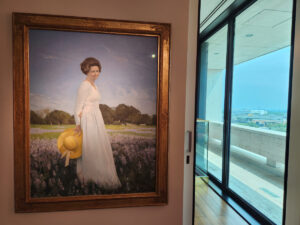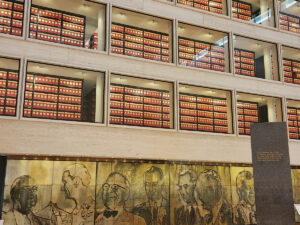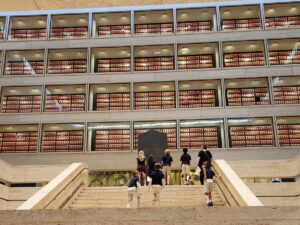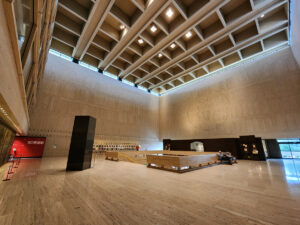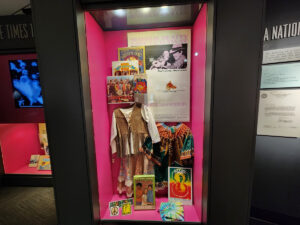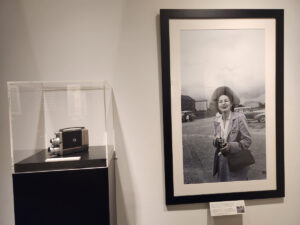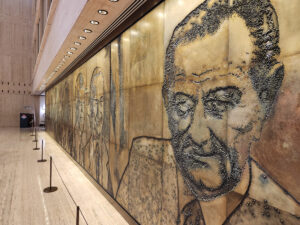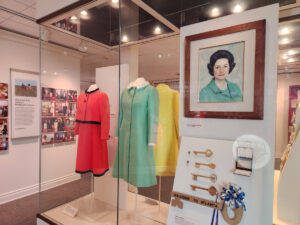- LBJ Library Offers Insight Into 1960’s
- Open Almost Every Day
- LBJ Library Documents Complicated Legacy of 36th President
- Lady Bird Johnson Was One Of Most Impactful First Ladies In U.S. History
- Influence of Lady Bird Johnson Still Felt In Austin Today
- Website Link
- 2313 Red River Street
- (512) 721-0200
- 2 Miles From Downtown Austin
LBJ Presidential Library Is Worth Visit
Texas has more presidential and libraries than any other state in the nation. But only one – Austin’s LBJ Presidential Library and Museum – honors a native-born Hill Country Texan and graduate of the University of Texas. A visit to the LBJ Presidential Library not only offers a chance to see exhibits and artifacts from the lives and times of Lyndon Baines and Lady Bird Johnson, but also provides context for many of the social and political issues that are still relevant today.
Exhibits include a replica of President Johnson’s Oval Office, where the various photographs, books and personal mementos shed light on the personality of one of our most complex presidents. You’ll also be able to listen in on historic telephone conversations LBJ had with foreign leaders and American elected officials as the issues of the day were debated and acted upon, as well as audio conversations with family members that offer insight into the highs and lows he encountered both as president and as a husband and father.
LBJ Presidential Library Is Open Almost Every Day
The LBJ Library is open almost every day from 9 AM to 5 PM, except for major holidays. Free parking is available for visitors directly in front of the library during library hours. Admission is free for children under 13 and there are discounts for seniors, military and college students. Food and drinks are not allowed in the library and there is no onsite cafe, but be sure to visit the museum gift shop before you leave. There are lots of cool t-shirts and collectibles available as well as books, posters and even 1960’s campaign buttons for purchase.
Important moments during the Johnson administration are brought to life using multimedia kiosks. Visitors can engage with touch-screen displays, and view historical footage. The library also hosts a range of events from educational programs for students to public lectures by historians. Special exhibitions often feature topics relevant to Johnson’s legacy or broader American history themes.
The average visitor to the museum may not have the need to make use of the extensive archival materials accessible to the public, but serious researchers and authors can turn to the more than 45 million pages of historic documents; 650,000 photos; 5000 hours of recordings and 2000 oral history interviews. It’s a reflection of the character of LBJ that this material is preserved in a building as imposing as Lyndon Baines Johnson was himself (he was 6 foot 3 inches tall!) .
It takes a couple of hours to go through the museum and you could easily spend half a day there. Comfortable footwear is recommended, as the museum spans several floors. Audio guides and docent-led tours can enrich your experience. Weekday mornings tend to be quieter, offering a more intimate viewing experience. Weekends and holidays might be busier but often feature special programs or events.
Library Documents Both Achievements And Controversial War
A Congressman from Texas, Lyndon B. Johnson became Vice President of the United States in 1961 after the election of President John F. Kennedy. Kennedy was assassinated in Dallas, Texas in 1963 and Johnson became President. After assuming the remainder of Kennedy’s term in office, Johnson was elected to another term. In all, the presidency of LBJ spanned 1963 to 1969. This was also one of the most legislatively important periods in U.S. history with significant and lasting impacts on American society, politics, and foreign policy. While the legacy of LBJ is multifaceted and includes landmark achievements, it is also controversial, especially in foreign affairs.
Johnson launched an ambitious set of social welfare programs aimed at eliminating poverty and racial injustice, collectively known as the “Great Society.” These included the establishment of Medicare and Medicaid, programs that provided health insurance to the elderly and low-income individuals, respectively, fundamentally changing healthcare in America.
While closely associated with major advancements in civil rights, Johnson’s legacy is heavily overshadowed by the Vietnam War. His decision to escalate U.S. military involvement in Vietnam was and remains highly controversial. The war led to significant loss of life, widespread protests, and deep divisions within American society. It also raised questions about presidential power, the credibility of the government, and America’s role in the world.
Born in a rural area west of Austin, Lyndon Johnson attended the University of Texas. Johnson saw the University of Texas as a fitting location for his presidential library because he believed that the university had given him much, and by situating his library there, he wanted to give something back, not only to the institution but also to the future generations of students and scholars who would visit.
Lady Bird Johnson Was One Of The Most Impactful First Ladies In U.S. History
The LBJ Presidential Library and Museum is also a testament to contributions of Lady Bird Johnson not only to her husband’s career, but to her own significant and multifaceted work in areas ranging from environmental conservation to social advocacy. By actively engaging with the American public and using the media effectively, Lady Bird helped to shape the cultural and social landscape of the 1960s. She was influential in promoting environmental awareness and beautification as national priorities, laying the groundwork for future environmental movements. Her influence extended beyond the traditional role of a First Lady, making her one of the most active and impactful First Ladies in U.S. history.
Lady Bird Johnson’s most enduring legacy is perhaps her work in environmental conservation and beautification. She believed that making America more beautiful was part of its emotional and spiritual uplift. Her efforts led to the Highway Beautification Act of 1965, often referred to as “Lady Bird’s Bill,” which sought to control outdoor advertising along America’s highways and encourage the planting of native flowers and plants along roadways.
Lady Bird Johnson was also a staunch advocate for the arts and humanities, believing in their essential role in American society. She played a key role in establishing the National Endowment for the Arts and the National Endowment for the Humanities in 1965, institutions that have since provided critical support for artists, writers, and scholars.
Lady Bird Johnson often served as a diplomatic and political asset to her husband. She campaigned extensively, including a notable whistle-stop tour through the South in 1964, where she addressed environmental and social issues, seeking to soften resistance to the Civil Rights Act and garner support for LBJ’s presidential campaign.Her grace, intelligence, and warm demeanor made her a popular figure both nationally and internationally, often softening the more brusque aspects of LBJ’s personality and politics.
Influence of Lady Bird Johnson On Austin Is Still Felt Today
After the end of the Johnson presidency, Lady Bird Johnson’s impact on Austin, Texas, was significant and enduring, reflecting her deep commitment to environmental conservation, beautification, and education. Her initiatives and legacy are visible across the city, influencing its development and character. Lady Bird Johnson Wildflower Center: Perhaps her most visible legacy in Austin is the Lady Bird Johnson Wildflower Center, which she co-founded in 1982. The center is dedicated to the preservation and promotion of native plants and natural landscapes.
In recognition of her contributions, many things are named after Lady Bird Johnson, including Lady Bird Lake bounded by Austin’s beautiful downtown hike and bide trail. Lady Bird Johnson’s impact on Austin is a testament to her vision and dedication to making America and her beloved Texas more beautiful and sustainable. Her legacy continues to shape the city’s environmental ethos, cultural richness, and community spirit, making her an enduring figure in Austin’s history.
The Johnsons’ legacy in Austin is visible in its educational institutions, public spaces, and cultural landmarks. They are remembered for their contributions to the city’s development, their commitment to public service, and their advocacy for the environment and education. A visit to the LBJ Presidential Library can be educational, insightful or perhaps even inspiring, but without doubt illustrates just one of the many the connections the City of Austin has to the Presidency of the United States. The LBJ Presidential Library is also close to other things to do in Austin like the Blanton Museum, the Texas State History Museum and the Texas State Capitol.



